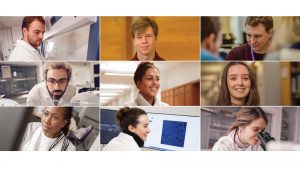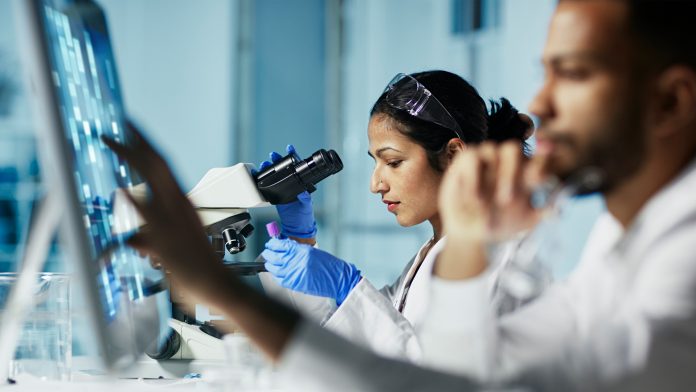How one North of England partnership is helping biomedical materials researchers respond to global healthcare challenges
Biomedical materials have advanced dramatically over the last 50 years and continue to evolve today. With a rapidly growing and ageing population, there is greater demand for more efficient and cost-effective healthcare interventions, and our goal at the Centre for Doctoral Training (CDT) in Advanced Biomedical Materials is to train an interdisciplinary cohort of students to compete in this global field.
We are developing tomorrow’s internationally leading postdoctoral engineers who will enable innovation between industry, clinicians, and academics to address areas of need. In order to do this, the CDT begins with a Manchester based three-month taught programme with a subsequent integrated training programme throughout.
The programme combines the strength and track record in biomaterials innovation, translation and industrial engagement of The University of Manchester and The University of Sheffield, aligning with the needs of the UK for resource, skills, industrial collaboration and cohort training.
Our four-year PhDs focus on developing and translating smart and responsive biomaterials with a particular emphasis on higher throughput, greater reproducibility of manufacture, and characterisation. Students work with industry partners and undertake clinically-relevant research and advanced projects at Manchester and Sheffield helping to forge the next generation of UK leaders in biomedical materials research.
All students receive training in bioelectronics; fibre technology; additive manufacturing; improved pre-clinical characterisation; manufacturing scale up; and reproducibility.
In addition to the academic aspect of our doctoral training programme, students also receive training in transferable skills such as project management, dissemination, and commercialisation. Equality, Diversity and Inclusion training is embedded throughout, ensuring that our students are cognisant of these principles post-training. Students also learn how to conduct research in a responsible and innovative manner taking into account any potential societal impacts that may emerge.
Conclusion
Whilst the project topics in this Centre for Doctoral Training are broad, each of the students will also undertake in-depth research into each of these biomedical material products and training in this field. This UK government investment of £6.7m will ensure that these students and following three cohort years will receive state-of-the-art training in research and leadership skills. This places the UK at an advantage, not only to benefit from the medical products being developed in these projects, but also from the investment in people in this area. We will see our students develop into independent researchers and go on to innovate and lead in both industry and academia. These researchers are definitely ones to watch in the future!
Current biomedical materials research projects
Current research project topics include:
Dom Williams – Polymer-allogenic tissue hybrid nano-fibre scaffold for ACL regeneration
Rupture of the anterior cruciate ligament (ACL) is one of the most frequent sporting injuries, resulting in chronic knee instability, alteration of the knee biomechanics and increases the propensity for early on-set osteoarthritis. Dom’s project aims to evaluate the efficacy of incorporating allogenic ACL tissue into an electrospun nano-fibrous polymer scaffold. It is hypothesised that allogenic ACL biomarkers shall support the regenerative response by upregulating gene expression and synthesis of ligament-specific proteins such as collagen I by native ligament fibroblasts.
Rob Bagley – Development of a nappy for the detection of Cytomegalovirus (CMV) in the urine of neonates
Rob’s task is to develop a nappy test strip that detects cytomegalovirus (CMV) in new-borns. CMV is the commonest congenital infection. 90% of cases are asymptomatic with symptoms often developing later in life, including hearing loss and organ failure. In order to detect all incidences of infection, the strip will contain antiviral materials to expose viral DNA and a fluorescent DNA dye to give the reading. This could improve the lives of thousands of children as a precursor to antiviral therapy.
Liam Johnson – Flexible, on-skin electronics for murine electrocardiogram (ECG) monitoring
In pre-clinical science, electrocardiograms play an important role in examining the electrical activity of mouse cardiac tissue, which can be interpreted to identify genetic disorders and discover new therapies. However, monitoring the heart of free-moving rodents requires a surgically implanted device, burdening the animal with a weight approximately 10% its body mass. Liam’s project aims to use ultrathin, flexible electronics to create an on-skin heart sensor, similar in appearance to temporary tattoos used by children. For which, various materials will be explored to engineer a system able to weather murine grooming behaviours and skin physiology.
Davide Verdolino – Understanding the mechanisms of action of collagen-based dressing to promote healing
Chronic wounds are a significant global problem, causing patient morbidity and a substantial financial burden on health services worldwide. A variety of topical therapies which supplement or mimic the collagen-rich extracellular matrix (ECM) have been developed to promote healing; however, their composition and efficacy vary, and a clear understanding of their mechanisms of action is lacking. Davide’s project will investigate the mechanisms of action of Promogran™ and competitor collagen-based products by utilising sophisticated in vitro and in vivo methods to determine how these dressings promote healing.

Grace McDermott – 3D bioprinting of tissue engineered meniscal constructs
Meniscal tissue engineering strategies have rapidly emerged in response to a lack of viable treatments for meniscal pathologies that affect over 1.5 million people across Europe and the USA. Current approaches have promising aspects, but the overall construct fails to mimic both the structural and functional organisation of native healthy menisci. Grace’s project aims to develop a truly biomimetic substitute through 3D bioprinting using advanced biomaterials and stem cell technology; capable of restoring knee function.
Sophia Read – Bioprinting the multiscale extracellular matrix (ECM) environment for Articular Cartilage repair
Articular cartilage (AC) is a complex 3D microenvironment that provides important mechanical properties for articulating joints. Loss of AC due to osteoarthritis or injury can result in joint immobility and long-term pain. Whilst significant advances have been made in developing tissue engineering scaffolds that mimic the macro-scale architecture of AC, little attention has been dedicated to recapitulating the organisation of collagen fibrils in the newly-formed cartilage. Sophia’s project seeks to do this by 3D bioprinting a scaffold, using advanced hydrogels and stem cells that aims to synthesise superior replacement AC.
Leona Ogene – Graphene-based bioinks for 3D printing of Articular Cartilage implants with enhanced bioactivity
Articular cartilage is a highly important tissue which lines the ends of the bones in our joints. Its primary function is to provide a smooth surface for pain free movement. Unfortunately, articular cartilage has a very poor capacity to repair itself once damaged. Leona’s project will attempt to use 3D bioprinters to regenerate cartilage by printing articular cartilage tissue implants. These printed implants will consist of stem cells and a new material called graphene oxide which I will use to gradually release bioactive molecules, that guide stem cells to develop into articular cartilage tissues.
Yasmine Osmani – 3D Printing of Anthropomorphic Phantoms for Magnetic Resonance Imaging (MRI) Guided Radiotherapy
The aim of Yasmine’s project is to develop a class of soft elastomeric materials with tuneable relaxation decay values that mimic those human tissues. These materials can subsequently be 3D printed to produce anthropomorphic MRI phantoms that simulate human tissue anatomically, geometrically and radiologically. Using these phantoms during pulse sequences development will better replicate the real clinical scenario and therefore can be used to plan image-guided radiotherapy (IgRT). The soft and elastomeric nature of the final printed phantom allows for the involuntary motions arising from cardiac and respiratory action to be simulated. During IgRT treatment planning, these motions can be accounted for, thus further improving the pre-treatment data therefore reducing the likelihood of damage to the non-cancerous organs and tissues.
Caitlin Jackson – Lab-based produced vascularised tissue for in vitro lab on a chip models of healthy and diseased tissue
Caitlin’s project will utilise high internal phase emulsions templating techniques to create an in vitro vascularised tissue via fabrication of a porous PCL PolyHIPE scaffold. The porous network will allow for vascular outgrowth to occur in a hydrogel-based well in which cell, cell spheroids and small biopsies can be placed. This will be developed to overcome the short comings in current models and provide an in vitro alternative to in vivo testing platforms. It will be used to explore healthy and diseased tissue models, particularly focussing on cancer models.
Cohort 2 biomedical materials research project listing

- Rachel Furmidge: Regenerating the oral mucosa in patients with MRONJ using synthetic poly(glycerol sebacate) scaffolds and uncultured adipose cells;
- Harry Lord-Moulding: Potential of graphene oxide in the repair and regeneration of musculoskeletal tissues;
- Matt Graham: Smart biomaterial composites with hierarchical architecture for ligament repair and regeneration;
- Rebecca Hanson: A novel 3D Osteochondral Scaffold with Mechano-identical properties of the native tissue for in situ tissue regeneration;
- Rebecca Steele: Development of graphene containing 3D printed scaffolds for orthopaedic applications;
- Raissa Barroso: Real-time, Low Cost, Point-of-Care Biomimetic Sensors for Pathogen Detection within Clinical Settings, exemplified against Aspergillus fumigatus;
- Gregor Mack: A smart disposable device for opthalmic point-of-care;
- Thomas Jepson: Integration of polymeric 3D scaffolds within a perfused organ-on-a-chip system for the development of a soft organ model;
- Kathryn Dickins: The Development of Drug-eluting Electrospun Devices for Clinical Applications in Gynaecology; and
- Marcin Gwiazda: Development of Artificial Retinas for the Treatment of Degenerative Eye Disease and the Augmentation of Human Vision.
Professor Sarah Cartmell
Director
Advanced Biomedical Materials CDT
The University of Manchester
ABMCDT@manchester.ac.uk
Tweet @AdvBioMedMatCDt
advanced-biomedical-materials-cdt.manchester.ac.uk







